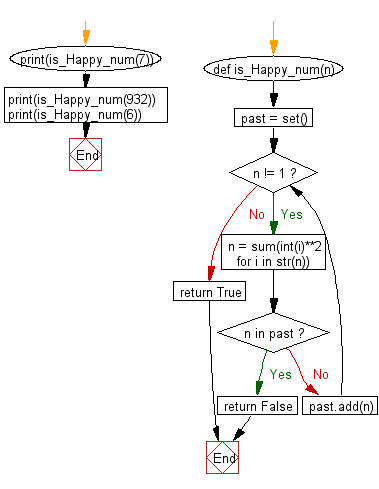Python: Check whether a number is "happy" or not
Happy Number Checker
From Wikipedia, the free encyclopaedia:
A happy number is defined by the following process:
Starting with any positive integer, replace the number by the sum of the squares of its digits, and repeat the process until the number equals 1 (where it will stay), or it loops endlessly in a cycle which does not include 1. Those numbers for which this process ends in 1 are happy numbers, while those that do not end in 1 are unhappy numbers.
Write a Python program to check whether a number is "happy" or not.
Sample Solution:
Python Code:
# Function to check if a number is a Happy Number
def is_Happy_num(n):
past = set() # Set to store previously encountered numbers during the process
while n != 1: # Continue the process until the number becomes 1 (a Happy Number) or a cycle is detected
n = sum(int(i) ** 2 for i in str(n)) # Calculate the sum of squares of each digit in the number
if n in past: # If the current number has been encountered before, it forms a cycle
return False # The number is not a Happy Number
past.add(n) # Add the current number to the set of past numbers
return True # If the process reaches 1, the number is a Happy Number
# Test cases
print(is_Happy_num(7))
print(is_Happy_num(932))
print(is_Happy_num(6))
Sample Output:
True True False
Explanation:
Here is a breakdown of the above Python code:
- Define a function named "is_Happy_num()" that takes a number 'n' as input.
- Initialize a set called 'past' to keep track of previously encountered numbers during the process.
- Use a while loop to continue the process until the number becomes 1 (a Happy Number) or a cycle is detected.
- Inside the loop, calculate the sum of the squares of each digit in the current number.
- Check if the current number has been encountered before. If yes, it forms a cycle, and the number is not a Happy Number.
- Add the current number to the set of past numbers.
- Return 'True' if the process reaches 1, indicating that the number is a Happy Number.
- Test the function with different inputs to check its functionality.
Visual Presentation:
Flowchart:

For more Practice: Solve these Related Problems:
- Write a Python program to determine if a number is happy by iteratively summing the squares of its digits and detecting cycles.
- Write a Python program to check if a given integer eventually reaches 1 through the sum-of-squares process.
- Write a Python program to use a set to track previously seen sums and determine whether a number is happy.
- Write a Python program to implement Floyd’s cycle-finding algorithm to efficiently check if a number is happy.
Go to:
Previous: Write a Python program to find the longest word in set of words which is a subsequence of a given string.
Next: Write a Python program to find and print the first 10 happy numbers.
Python Code Editor:
Have another way to solve this solution? Contribute your code (and comments) through Disqus.
What is the difficulty level of this exercise?
Test your Programming skills with w3resource's quiz.
